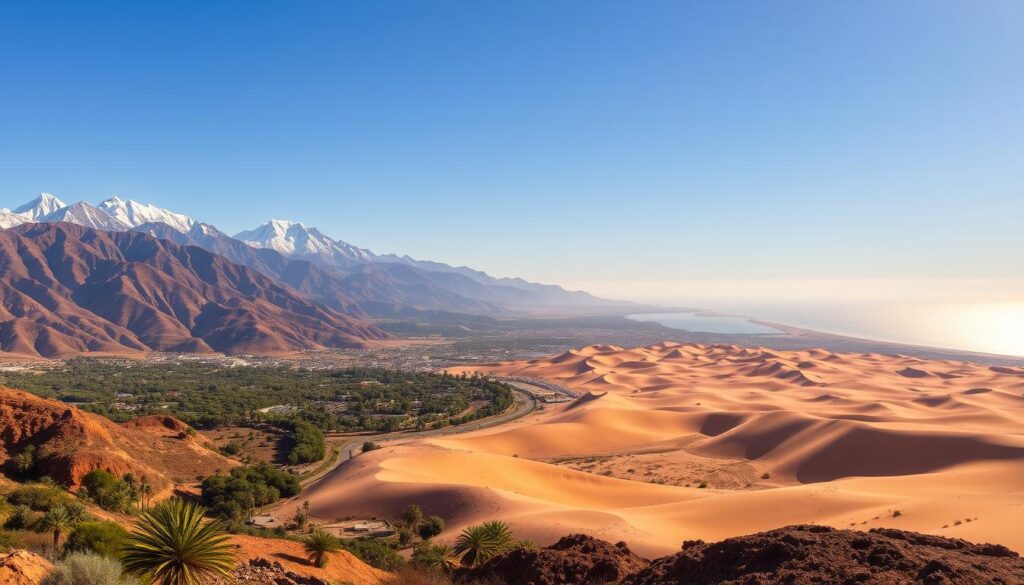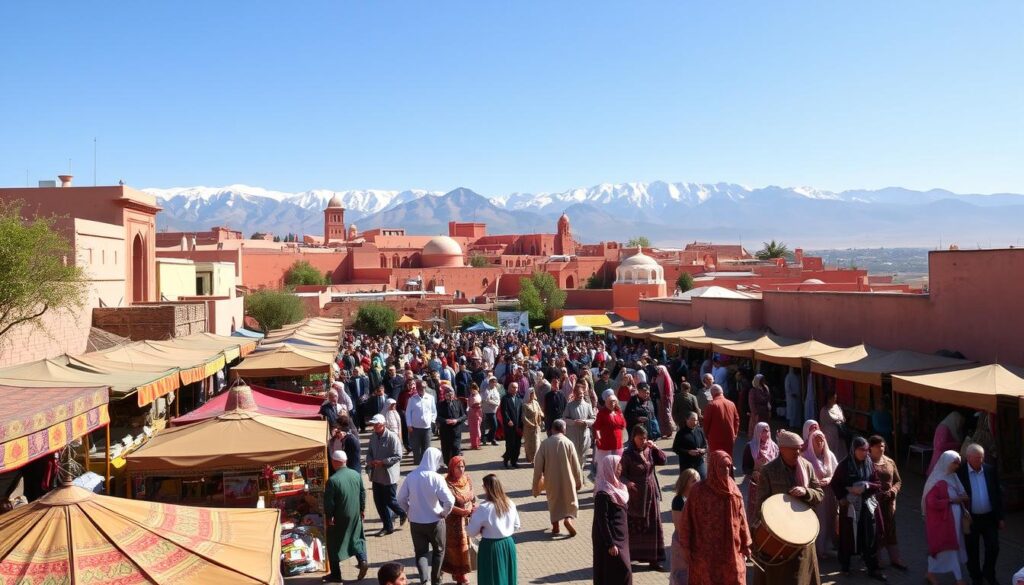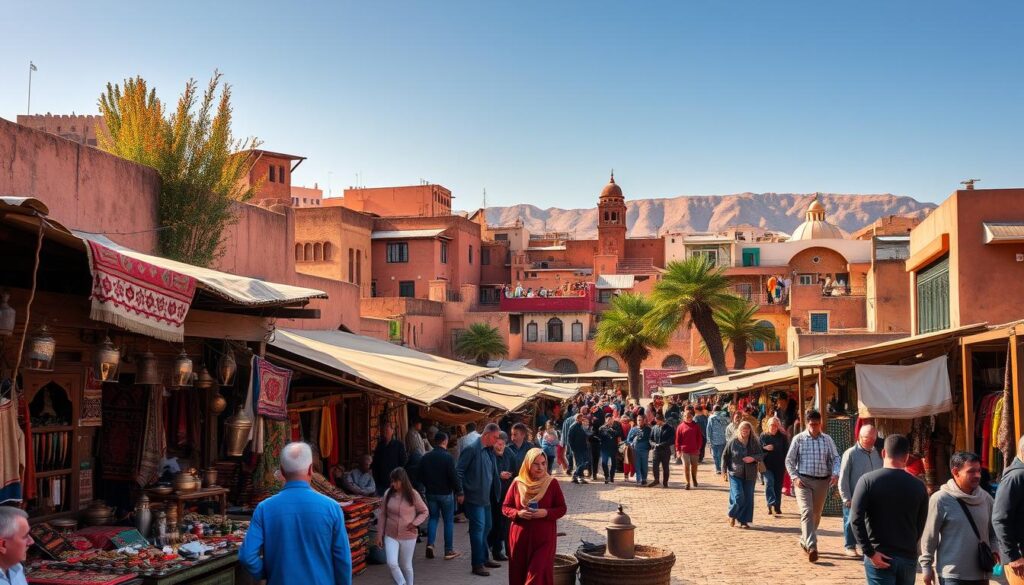Morocco is a fantastic year-round vacation destination, offering diverse experiences that cater to various interests and holiday needs. The country’s climate varies dramatically across different regions, making it essential to choose the right season for your trip.
From coastal retreats to mountain adventures and desert excursions, Morocco has something for everyone. Understanding the weather conditions and seasonal variations across the country is crucial for planning the perfect trip.
Whether you’re looking to escape the cold winters of Europe or North America, or experience the unique opportunities that Morocco offers, our guide will help you determine the ideal time to plan your adventure. Contact our travel experts at +16823085820 / +212773081754 or [email protected] to create your personalized Moroccan experience.
Key Takeaways
- Morocco offers diverse experiences throughout the year.
- Understanding seasonal variations is crucial for planning.
- Spring and fall generally offer the most pleasant weather.
- Summer is ideal for coastal retreats, while winter is perfect for skiing.
- Contact our experts to plan your personalized Moroccan adventure.
Understanding Morocco’s Climate and Seasons
Understanding the climate and seasons in Morocco is crucial for planning the perfect trip, whether you’re exploring cities or trekking through mountains. Morocco’s climate is characterized by significant regional variations, making it essential to grasp these differences for a well-planned adventure.
Overview of Morocco’s Diverse Climate Zones
Morocco encompasses a variety of climate zones, from the Mediterranean climate in the north to the Saharan climate in the south, and the Atlantic coastal climate. The country’s diverse geography, including mountains, deserts, and coastal regions, contributes to its climatic diversity. For instance, the Atlas Mountains experience a temperate climate with cold winters and mild summers, while the desert regions are known for extreme heat during the day and cooler temperatures at night.

Year-Round Temperature Variations
Temperature variations in Morocco are significant throughout the year. In Marrakesh, for example, winter temperatures range from 64-68°F, while summer temperatures can soar to 91-100°F. Similarly, in the Erg Chebbi desert, temperatures can drop to below freezing at night during winter but reach as high as 100-109°F during the summer months. Understanding these temperature fluctuations is key to packing appropriately and making the most of your visit, regardless of the time of year you choose to travel.
The weather in Morocco during different months can greatly impact your travel experience. Spring and fall are considered ideal seasons to visit, with pleasant temperatures prevailing across most regions. In contrast, summer brings intense heat, especially to inland areas and the desert, while winter can be cool, particularly in the mornings and evenings, even in typically warm areas.
Spring in Morocco: March to May
Morocco’s spring season offers a unique blend of culture, adventure, and natural beauty. As the country transitions from winter to spring, the landscape transforms, and various festivals take place.
Weather Conditions and Temperatures
During spring, Morocco experiences mild temperatures, ranging from 15°C to 25°C (59°F to 77°F). The weather is generally pleasant, making it ideal for outdoor activities and sightseeing.
Best Spring Activities and Experiences
Spring is an excellent time to explore Morocco’s diverse landscapes. Visitors can enjoy hiking in the Atlas Mountains, exploring the Sahara Desert, or relaxing on the coastal beaches. The pleasant weather also makes it a great time for cultural experiences, such as visiting historical sites and participating in local festivals.
Spring Festivals and Cultural Events
Morocco hosts various festivals during the spring. The Festival of Roses in the M’Goun Valley, typically in May, celebrates the rose harvest with music and traditional ceremonies. The International Nomads Festival in M’hamid El Ghizlane brings together musicians from nomadic cultures. Additionally, spring may coincide with Eid al-Fitr, offering a unique cultural experience.
| Festival/Event | Location | Month | Description |
|---|---|---|---|
| Festival of Roses | M’Goun Valley | May | Celebrates the rose harvest with music and traditional ceremonies |
| International Nomads Festival | M’hamid El Ghizlane | March | Brings together musicians from nomadic cultures |
| Eid al-Fitr | Various locations | Varies | Marks the end of Ramadan with special foods and family gatherings |

Summer in Morocco: June to August
The summer season in Morocco is characterized by long days and nights, ideal for outdoor music events. As the temperatures rise, the country’s vibrant culture comes alive with numerous festivals and activities.
Managing the Heat
Summer in Morocco can be quite hot, especially in the desert and cities. To manage the heat, visitors often start their day early, exploring the bustling souks and historic sites before the peak sun hours. Staying hydrated and taking breaks in shaded areas or cafes is essential.
Coastal Retreats
The coastal towns offer a cooler retreat from the inland heat. Essaouira, with its Atlantic breeze, is a popular destination for beachgoers. Activities such as surfing, windsurfing, and kitesurfing are popular along the coast, making it an ideal time for water sports enthusiasts.
Summer Festivals
Summer is a peak season for music festivals in Morocco. The Gnaoua World Music Festival in Essaouira and Jazzablanca in Casablanca are notable events that attract international artists and audiences. These festivals showcase a mix of traditional and contemporary music, reflecting the country’s rich cultural heritage.
| Festival | Location | Month |
|---|---|---|
| Gnaoua World Music Festival | Essaouira | June |
| Jazzablanca | Casablanca | June |
| Fez Festival of World Sacred Music | Fez | June |
| Asilah Festival | Asilah | July |
Fall in Morocco: September to November
As the summer heat dissipates, Morocco transforms into a vibrant destination, perfect for travelers seeking a mix of adventure and relaxation. The fall season, spanning from September to November, offers a unique blend of cultural experiences, outdoor activities, and pleasant weather.
Perfect Weather and Fewer Crowds
During the fall, Morocco enjoys mild temperatures, making it an ideal time to explore the country’s diverse regions. With fewer tourists compared to the peak summer months, visitors can enjoy a more relaxed experience when traveling to popular destinations like Marrakesh. The comfortable weather conditions make it perfect for city exploration, allowing travelers to wander through historic centers without the intense heat of summer.
Harvest Season and Culinary Experiences
Fall is also the harvest season in Morocco, providing a unique opportunity to experience the country’s rich culinary heritage. Visitors can enjoy fresh produce, local wines, and traditional dishes made with seasonal ingredients. The harvest season is particularly notable in the countryside, where travelers can witness traditional farming practices and participate in local festivals.
Fall Activities and Events
Fall in Morocco is characterized by a range of exciting activities and events. Some of the top experiences include:
- Desert excursions with ideal temperatures for camel treks and overnight camping in the Sahara.
- Hiking in the Atlas Mountains, with clear skies and moderate temperatures.
- The Dakhla Kitesurfing World Cup, an international competition held in late September.
- Photography opportunities with exceptional light conditions and unique golden hues.

Winter in Morocco: December to February
From the snow-capped Atlas Mountains to the warm desert landscapes, Morocco’s winter season is a time of diverse experiences. While the weather varies across regions, the country’s cultural heritage takes center stage during this period.
Regional Winter Weather
Winter brings different weather conditions to various parts of Morocco. The Atlas Mountains receive snowfall, making them ideal for winter sports, while the desert regions remain relatively warm. Coastal cities like Essaouira and Rabat experience mild temperatures, making them pleasant destinations during this time.
Winter Sports in the Atlas
The Atlas Mountains offer a range of winter sports, including skiing and snowboarding. Resorts like Oukaimeden provide opportunities for enthusiasts to enjoy these activities amidst breathtaking scenery. The region’s natural beauty and outdoor activities make it an attractive destination for travelers seeking adventure.
Celebrations and Cultural Experiences
Winter is a time for celebration in Morocco, with various cultural events taking place across the country. Major cities like Marrakesh and Casablanca host epic celebrations during the Christmas and New Year holidays, blending international festivities with local traditions. The Amazigh New Year, known as Yennayer, is another significant cultural event that occurs in January, offering travelers a unique glimpse into Morocco’s rich cultural heritage.
During the winter months, visitors can enjoy a more intimate experience at cultural sites and museums, as there are fewer tourists. Traditional hammams become particularly appealing, offering a warm and authentic cultural experience. Winter evenings often feature cultural performances in riads and restaurants, with traditional music, storytelling, and dance becoming central to the visitor experience.
Best Time to Visit Morocco by Region
Morocco’s varied landscapes and climates mean that the best time to visit can differ greatly from one region to another. Understanding these regional differences is crucial for planning an optimal trip.
Coastal Cities: Essaouira, Rabat, Casablanca
The coastal cities in Morocco enjoy a mild climate year-round, making them suitable for visits at any time. However, the summer months (June to August) are peak tourist season, with warm weather and lively beach activities. In contrast, the spring (March to May) and fall (September to November) offer pleasant temperatures and fewer crowds, making them ideal for those seeking a more relaxed experience.
Imperial Cities: Marrakesh, Fez
The imperial cities are best visited during the spring (March to May) or fall (September to November), when the temperatures are comfortable, and the crowds are manageable. Summers can be very hot, while winters might be cool, especially in the mornings and evenings. These periods allow for a more enjoyable exploration of the vibrant souks and historical sites.
Atlas Mountains and Hiking Trails
The Atlas Mountains offer a cooler climate compared to the desert and city areas, making them a great destination for hiking and trekking. The best times to visit are spring and fall, when the weather is mild and conducive to outdoor activities. Winters can be cold, with potential snowfall, while summers are pleasant but can be busy.
Sahara Desert Experiences
The Sahara Desert experiences extreme temperature variations, making the timing of desert excursions crucial. Spring (March-May) and fall (September-November) are ideal, with comfortable daytime temperatures (70-85°F/21-29°C) and cool nights. Summer is extremely hot, with temperatures often exceeding 115°F (46°C), while winters can be cold at night, requiring proper gear.
In conclusion, planning your visit according to the region’s best time ensures a more enjoyable and comfortable experience in Morocco. Whether you’re exploring coastal cities, imperial cities, the Atlas Mountains, or the Sahara Desert, timing is everything.
Best Time for Specific Activities in Morocco
With its varied climate and rich cultural calendar, Morocco is a year-round destination, but certain activities are best enjoyed during specific times of the year.
Surfing and Water Sports
The best time for surfing and water sports in Morocco is from September to November and from March to May, when the waves are consistent and the weather is pleasant. Travelers can enjoy surfing in Taghazout, known for its excellent surf conditions.
Hiking and Trekking Adventures
For hiking and trekking adventures, spring (March to May) and fall (September to November) are ideal due to the mild temperatures and fewer crowds. The Atlas Mountains offer numerous trails for all levels.
Cultural Festivals and Music Events
Morocco hosts various cultural festivals and music events throughout the year. Summer is a great time to experience the vibrant music festivals, such as the Essaouira Gnawa Music Festival.
Photography and Sightseeing
The best time for photography and sightseeing in Morocco’s cityscapes and landscapes is during spring and fall, when the weather is mild and the light is soft. Visiting during these seasons allows for a more authentic experience with fewer crowds.
Shopping in Souks and Markets
Shopping experiences in Morocco’s souks and markets vary throughout the year. Spring and fall offer the most pleasant conditions for browsing. In contrast, winter means fewer tourists, potentially leading to more relaxed shopping experiences.
Planning your trip according to these optimal times can significantly enhance your experience in Morocco, whether you’re exploring the countryside or enjoying the urban delights.
Planning Your Perfect Moroccan Adventure
Planning a trip to Morocco requires more than just choosing a destination; it involves timing your visit perfectly. The best time to visit Morocco is during spring (March-May) or fall (September-November), when the weather is warm but pleasant.
For a tailored experience, consider contacting our travel experts at +16823085820 / +212773081754 or email [email protected]. Our guides can help you create an itinerary that suits your interests, whether you’re exploring the Sahara Desert, hiking in the High Atlas, or immersing yourself in Morocco’s vibrant culture.